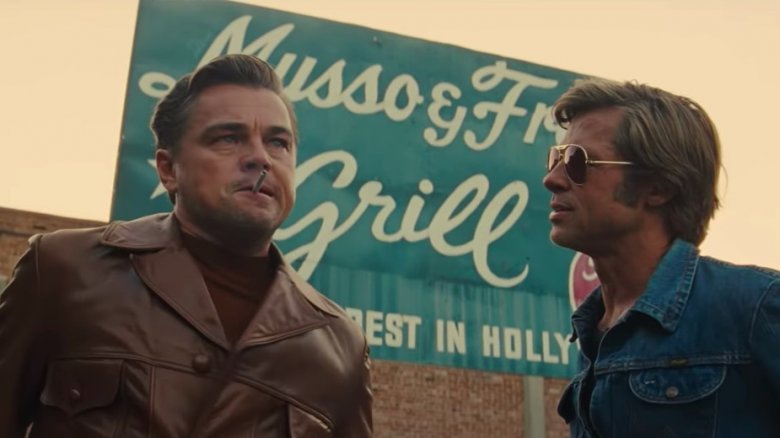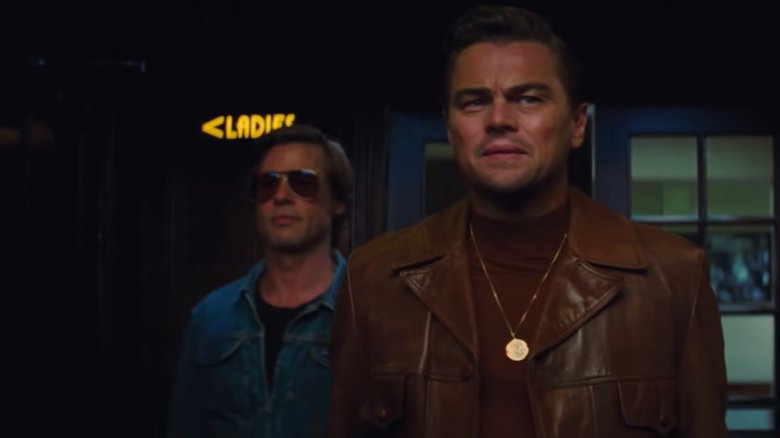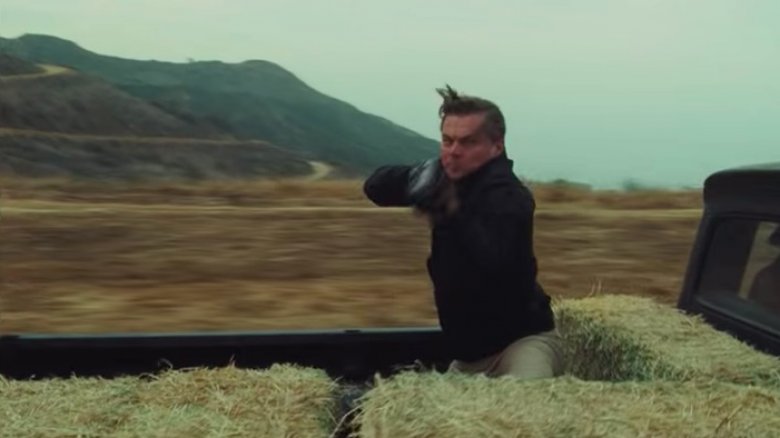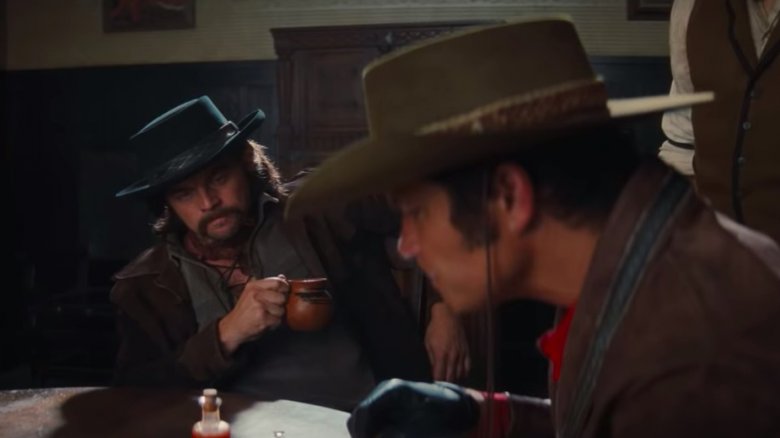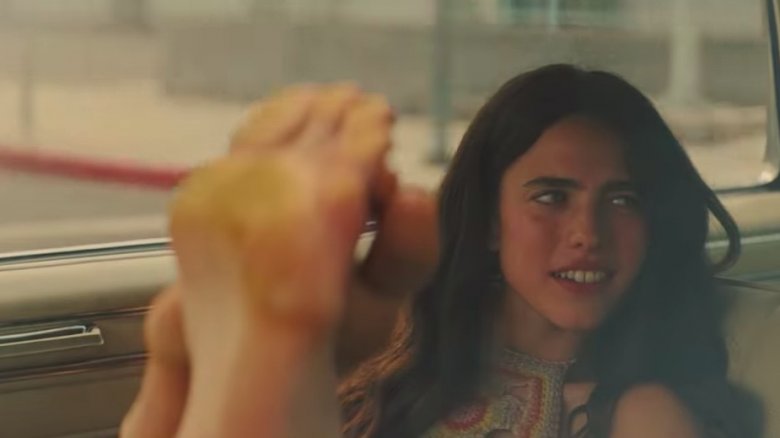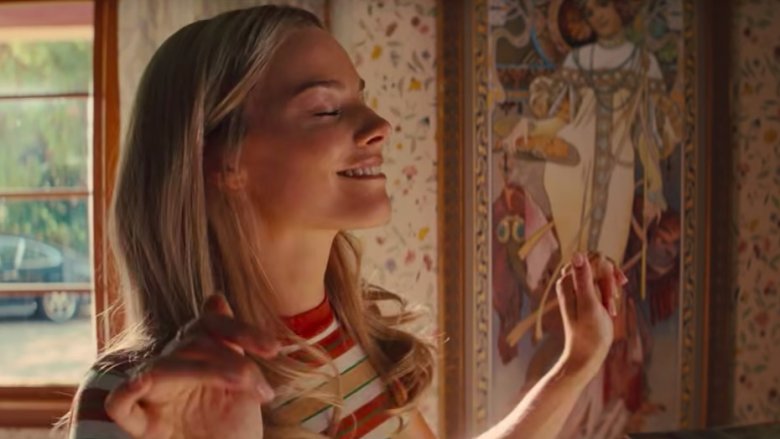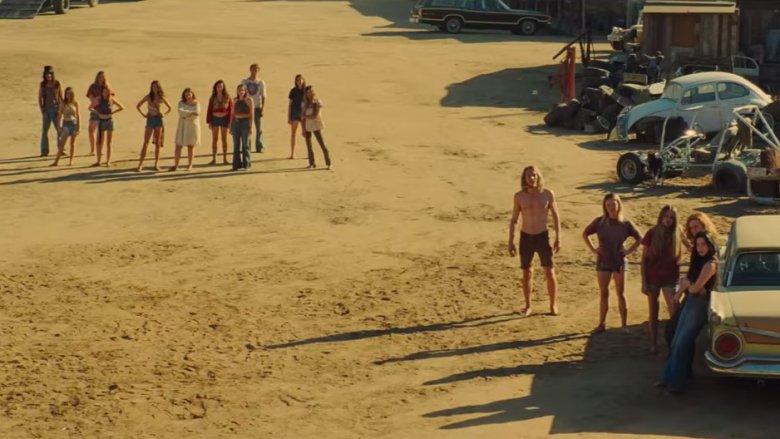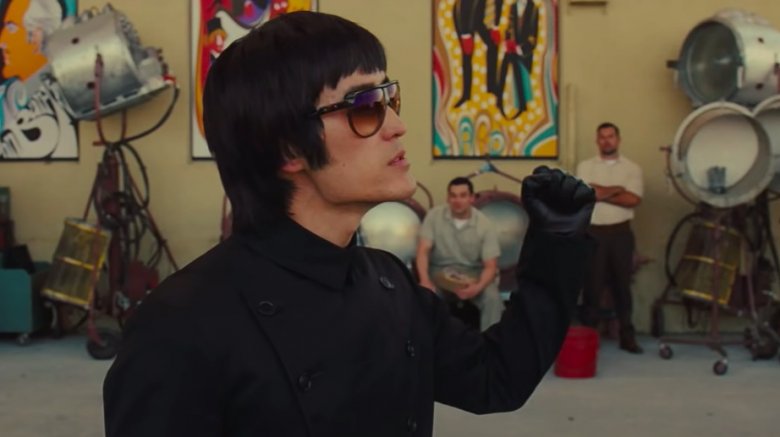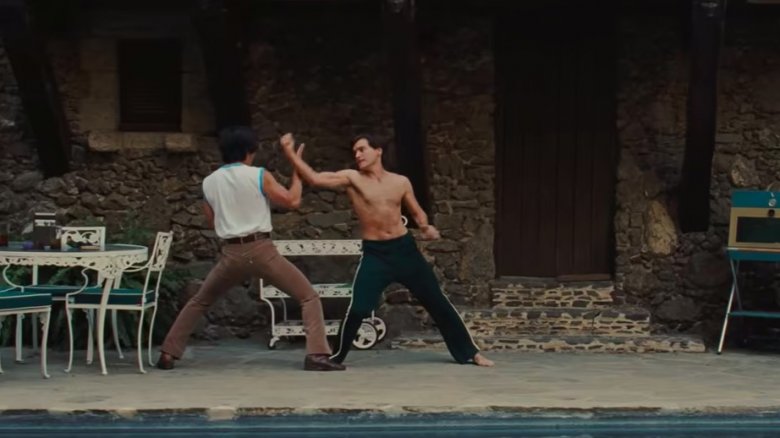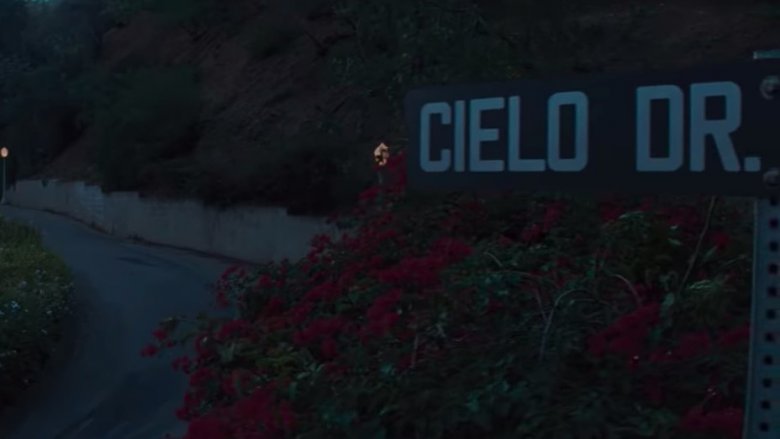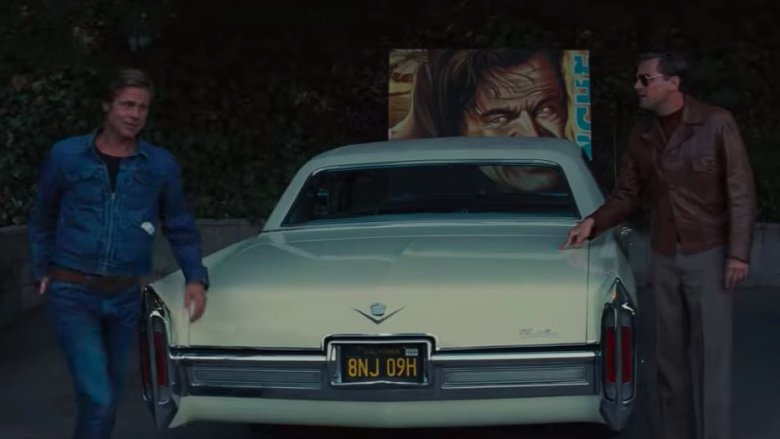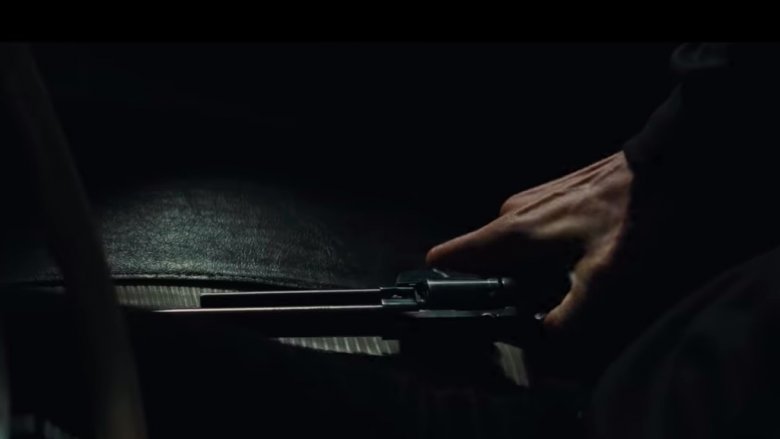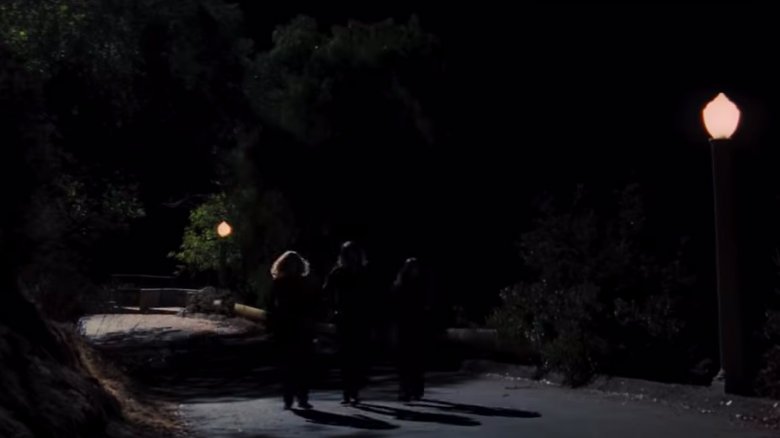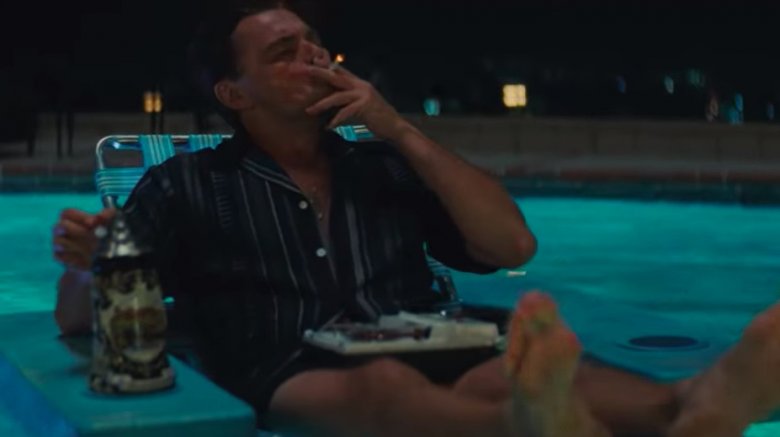All The Ways Once Upon A Time In Hollywood Lied To You
We'll just come right out and say it upfront. Most of Quentin Tarantino's new film Once Upon a Time in Hollywood is not a documentary of real history. The two main characters never existed, their entire storyline is false, and even the stuff that was taken from history has been drastically altered in places to fit the narrative.
To be fair, though, Tarantino never tried to tell anyone that he was making a historically accurate film. Once Upon a Time in Hollywood is a fairy tale, and if you need proof you have only to look as far as the title. "Once upon a time" is how you begin a fairy tale, and fairy tales are never, ever historically accurate.
That said, Quentin Tarantino's 1960s Hollywood is so lovingly detailed that it would be difficult to find inaccuracies in the set, costumes, or even the mood of the film. And some of the real moments from history are presented faithfully, with one major exception, which is why it might be difficult for viewers to separate fact from fiction. It's probably a little nitpicky to try and sift out the fictions from a movie that's largely fictionalized, but since there's so much truth mixed into Tarantino's latest film we thought it would be helpful to point out the major liberties the film takes with the truth. And we will be discussing the ending, so consider this your spoiler alert.
Surprise! Rick Dalton and Cliff Booth never existed
Apart from the ending, which we'll get to in a moment, the biggest mistruth in Once Upon a Time in Hollywood was basically the entire story arc. Once Upon a Time in Hollywood tells the tale of Rick Dalton (Leonardo DiCaprio), a washed up cowboy actor who once had his own Western TV show and is now relegated to playing baddie of the week. His best friend, handyman, and personal chauffeur is Cliff Booth, played by a surprisingly weathered-looking Brad Pitt.
Both of these characters are fictional. They're fictional, their story is fictional, and their tenuous connection to Sharon Tate was nonexistent, because they were nonexistent. And yet, the movie isn't really about Sharon Tate or the Manson family, it's about these two inventions of Quentin Tarantino's mind. The very real characters that occupied Hollywood in the late 1960s are simply woven into Rick and Cliff's fictional narrative, which makes it difficult to sift the reality out of the rest of the story.
According to Esquire, though, the friendship between Booth and Dalton was loosely based on the relationship between Burt Reynolds and stuntman Hal Needham. Needham, like Pitt's Booth, was tough, loyal, and unflappable. The two even shared a house for five years and "never, ever had a cross word." Incidentally, Burt Reynolds would have had a small part in Once Upon a Time in Hollywood, but he died before his scene could be shot.
Some, but not all, of the TV shows and movies in Once Upon a Time in Hollywood were made up
Since Rick and Cliff weren't real people, it stands to reason that the show that made them famous probably wasn't real, either. According to Bustle, Bounty Law was invented for the movie, though Tarantino says the fictional series was heavily influenced by a Western television show of the same era called Wanted Dead or Alive. Similarly, the Italian films Kill Me Quick, Ringo, Said the Gringo, which Rick goes on to star in at the end of Once Upon a Time in Hollywood were also fabrications. The (incredibly racist) Red Blood, Red Skin movie was not real but was inspired by a real movie from the time.
But not all of the shows featured in the film were made up — The FBI was a real show that ran from 1965 to 1974, and Lancer, the show that Rick Dalton is working on while simultaneously having his midlife crisis, was also real. It's easy to understand that creative choice because you can't just inject your fictional character into a starring role in a real TV show, though you can give him a guest spot pretty easily.
That's not how Hollywood shot TV shows in the 1960s
For all of Quentin Tarantino's devotion to the details, he did get something really wrong. According to NPR, 1960s cinematography was not on par with the cinematography of the modern era. But Rick Dalton's guest spot on Lancer was shot in much the same way a filmmaker might shoot a modern movie, with long takes and fancy camera work.
In reality, 1960s television was a lot rougher than what we're shown in that scene, but Once Upon a Time in Hollywood's cinematographer Robert Richardson told IndieWire that the choice was deliberate, so it's not like Tarantino just didn't bother to watch a few spaghetti Westerns before he shot those scenes. "The level of sophistication and the camera moves wouldn't have been done at that time," Richardson said. "It's really a Quentin touch. He wanted to make this his next Western, as a central point. He achieved that goal but I wouldn't call it a 'spaghetti Western.'"
Once Upon a Time in Hollywood's Pussycat was not a real person
Of all the Manson Family characters depicted in Once Upon a Time in Hollywood, it's the one called "Pussycat" who is the most fleshed out and the most memorable. But the character is really only partially based on a real person. According to Bustle, there was a Manson Family member named "Kitty Kat" (real name Kathryn Lutesinger) who fled the ranch after Manson's arrest and ended up giving investigators critical information that helped them solve the murders of Sharon Tate and her friends.
The real-life Lutesinger was a different sort of character than Pussycat, though. Pussycat is drinking the Manson Family Kool-Aid — she's clearly enamored with Manson and feels right at home on the ranch. Lutesinger, on the other hand, did not feel like she belonged with the Family and was sometimes at odds with Manson himself. Once, she fell asleep during one of his probably-boring and narcissistic speeches and when she woke up he was punching her in the face. So she was hardly the free spirit that her movie counterpart was — if you can even say that the character was intended to be more than just a girl with a similar name.
Roman Polanski and Sharon Tate did not have a Hollywood fairy-tale romance
In the film, Rick Dalton lives next door to Roman Polanski and Sharon Tate. History mostly remembers Roman Polanski as the guy who did some Very Bad Things and then fled to Paris to avoid punishment; history mostly remembers Sharon Tate as the woman who was brutally murdered by members of the Manson Family. Once Upon a Time in Hollywood remembers them differently — as the jet-setting, party-loving couple who spark envy in DiCaprio's already troubled character.
Tate's story is woven into the narrative of the film, and her sister Debra Tate was evidently so impressed with Margot Robbie's performance that she told Vanity Fair she felt like she'd been given a chance to see her sister again. But there were a few underlying details about the Polanski/Tate romance that are missing from the film; that is, if you believe the expose about the couple that was published in 2016.
According to Sharon Tate: A Life, Polanski was controlling, sometimes cruel, and would often pressure his wife into taking drugs and participating in humiliating sexual activities, some of which he filmed and then showed to his friends at parties. We don't see that in the film, though, which portrays the romance in a much more innocent light. Of course, the film wasn't really about Sharon Tate, but about the forces at work outside her personal Hollywood bubble.
Cliff Booth escaped the Mansons in Once Upon a Time in Hollywood, but a real-life stuntman did not
Cliff Booth was partly based on stuntman Hal Needham, but there are shades of other real-life people in his story, too. In the film, Cliff finds himself at Spahn Ranch, which is infested with sinister hippies in much the same way that George Spahn's filthy little shack appears to be infested with rats. Cliff once worked for George Spahn, and he becomes concerned that the ranch's new occupants might not exactly have George's best interests at heart. In what is probably the most suspenseful scene in the film, Cliff braves the herd of sinister hippies so he can check on George. Afterward, he discovers that one of Manson's minions has punctured his tire with a knife.
According to the website Charles Manson: The True Story, there was a real-life stuntman named Donald Shea who worked as the Spahn Ranch's foreman and did not get along with Charles Manson. Worse, he complained to George about the Manson group and suggested that they might all be better off if the Manson Family went elsewhere. You can guess how Manson reacted to that — he had Shea murdered and buried on a nearby hillside.
One of the men responsible for Shea's death was Steve "Clem" Grogan — in the film, he's the guy who punctures Cliff's tire and gets the crap beaten out of him for his trouble. You can just call that a little alternate-reality revenge on behalf of Donald Shea.
Bruce Lee was probably never beaten up by a stuntman
There are a few fans of Bruce Lee and old martial arts films who are unhappy about Bruce Lee's portrayal in Once Upon a Time in Hollywood. Because Tarantino's version of Bruce Lee is an arrogant jerk whose kung fu vocalizations sound ridiculous. And what's more, Lee gets taken down by Brad Pitt's Cliff Booth. And it's not like he gets knocked over a couple of times in an even fight, either; Booth beats the stuffing out of Lee and even tosses him into the side of a perfectly nice car, leaving a Bruce Lee-sized dent.
It doesn't seem like anything close to this ever happened in reality. Bruce Lee legend holds that he only ever lost one fight in his whole life, and that was when he was 13 years old. So he certainly wasn't ever defeated by some random washed-up stuntman, though he was rather famously challenged to a fight in 1964 by a guy named Wong Jack Man. According to Mental Floss, Lee and Wong fought for 20 minutes and the fight ended when Lee got the upper hand and then bystanders stepped in and separated them. The match wasn't a loss for Lee, but it did change the way he fought — he devoted himself to more rigorous training and went on to become a star. A star who never got the stuffing beat out of him by some random stuntman.
Bruce Lee probably wasn't with Jay Sebring on the day of the murders
The movie ends before the aftermath of the Manson Family murders. Well, in this movie there were no murders, so therefore there could be no aftermath. But it does allude to some of the things that happened after the real-life murders. At first, no one had any idea who might have wanted Sharon Tate and her friends dead, and Polanski was convinced it was someone they knew. And for a while, he suspected Bruce Lee. According to Esquire, there was even a rumor that Lee had been with one of the victims — Jay Sebring — on the day of the murders.
In Once Upon a Time in Hollywood, we see Lee actually training with Sebring on the day prior to the Manson Family's noisy trek up Cielo Drive, but that's all based on an unsubstantiated rumor. There's no evidence that Lee was with Sebring that day — Lee's widow could not recall him going there, and there was no note of it in his training logs, either.
Roman Polanski and Sharon Tate didn't have any next-door neighbors like in Once Upon a Time in Hollywood
In the film, Roman Polanski and Sharon Tate are not just Rick Dalton's neighbors — they're his next-door neighbors. In fact their houses are so close that Rick has a conversation with Jay Sebring through Sharon Tate's security gate while standing in his own driveway. But in real life, the Polanski house was not really close to anything.
There was no house next door to 10050 Cielo Drive, where Polanski and Tate lived in the summer of 1969. According to Helter Skelter: The True Story of the Manson Murders, Cielo Drive is a narrow, windy road that dead ends at the home, and the house itself is more than 100 feet from the gate where Rick and Jay had their conversation at the end of the film. And it's unlikely that anyone in the neighborhood ever heard Sharon Tate playing loud music on a warm afternoon because the closest neighbor, at 10070 Cielo, was almost 100 yards away. So Tarantino took some real liberties with the real estate, by adding a whole additional house to the neighborhood.
The occupants of the nearest house were not the washed-up former stars of spaghetti Westerns
The "neighbors," if you can really call someone your neighbor when they live a whole NFL football field away from you, were not famous movie stars, or even washed up former movie stars. They were completely-regular-people Mr. and Mrs. Seymour Kott, and on the night of the murders they'd just finished hosting a dinner party. According to Helter Skelter: The True Story of the Manson Murders, Mrs. Kott told police that their guests left around midnight, and not long after that she heard three or four gunshots, which seemed to have come from the direction of the Polanski residence. She didn't hear anything else, though, so she went to bed. The next morning, Seymour Kott went out to retrieve his newspaper at about 7:30 and noticed that the Polanski's bug light was still on, and that there was a loose wire dangling over their gate.
And so ends the neighbors' involvement in the Manson murders. There were other witnesses, including a counselor at a nearby kids camp who heard a man screaming "Oh God, no, please don't! Oh, God, no, don't, don't, don't," and several others who heard gunshots. But none of those people resembled Rick Dalton and Cliff Booth.
No one confronted the Manson Family in the road
In the film, the three murderers drive brazenly up the road into the cul de sac at the end of Cielo Drive, seemingly unconcerned about their lack of stealth — their car is a junker with a broken muffler and would almost certainly have been heard by the neighbors and everyone else within a quarter of a mile if that's what they'd actually done in real life. Rick is enraged that there are hippies on his street messing up the peace and the ambience, so he staggers out in his bathrobe and proceeds to berate them while simultaneously drinking margaritas directly from his blender pitcher.
The Manson acolytes drive away and park at the bottom of the hill, and have a brief Tarantino-esque conversation about what just happened. Then on impulse, they decide they're going to kill Rick instead of the occupants of 10050 Cielo Drive.
This, of course, is pure fiction. No one confronted the Manson Family in the road, no one knew they were coming, and no one changed their minds.
Linda Kasabian did not run off in the getaway car
There was nothing comical about the murders of Sharon Tate and her friends in the early hours of August 9, 1969. But Quentin Tarantino, being Quentin Tarantino, does love to turn horrible violence into absurd humor. In the film, we see the four murderers ominously walking up the hill, armed with killing tools and ready to carry out Charles Manson's orders. Then one of them — Linda Kasabian — stops walking and tells the others that she's left her knife in the car. Tex Watson tosses her the keys, and moments later they watch as she peels off in their getaway car.
That's fiction, too. According to Bustle, Linda Kasabian didn't participate in the murders, but she didn't run away, either. She drove the Manson Family to the crime scene and then she acted as a lookout, though after witnessing part of the attacks she went back down the hill to where the car was parked and waited there while the killers finished the job.
Linda Kasabian later served as a prosecution witness, and was granted full immunity in exchange for her testimony.
And finally, the end. It didn't end that way.
Okay so duh. Everyone knows how the story really ended — the killers tied up Sharon Tate and her friends and stabbed them to death while they all begged for their lives. Sharon Tate was stabbed 16 times. She was eight months pregnant.
In Tarantino's fairy tale, the ending is different. The Manson Family enters Rick Dalton's house instead of the house at 10050 Cielo Drive. They encounter Cliff Booth, who has just smoked an acid-dipped cigarette and isn't sure if they're real. He recognizes them from their earlier encounter at Spahn Ranch, but he can't recall Tex Watson's name. "I'm the devil," says Tex, echoing a line that the real Tex said to Sharon Tate and her friends, "and I'm here to do the devil's business." "Nah," Cliff replies. "It was dumber than that."
And then, Cliff sicks his dog on them and they all die. Well, two of them are gratuitously mauled by the dog and the other one dies when Cliff bashes her head repeatedly against a rotary phone. One of the two girls crashes blindly through a window and ends up in the pool, and then Rick finishes her off with a flamethrower. It's another example of Tarantino's now-famous alternate reality revenge — if only we could go back in time and give the bad guys what they deserve, then washed-up TV cowboys could make friends with Sharon Tate and live happily ever after.
